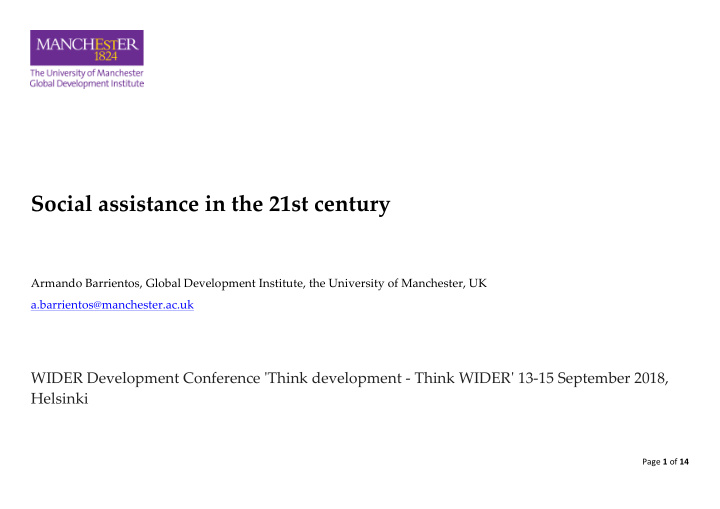



Social assistance in the 21st century Armando Barrientos, Global Development Institute, the University of Manchester, UK a.barrientos@manchester.ac.uk WIDER Development Conference 'Think development - Think WIDER' 13-15 September 2018, Helsinki Page 1 of 14
The presentation: Large expansion of social assistance provision in low and middle income countries ...pointing to an emerging architecture of welfare institutions with social assistance having a prominent role ...and highlighting significant research gaps Why the expansion of social assistance in LMICs? The relative weight of protection and social investment The politics of vertical redistribution Page 2 of 14
Social policy, social protection, social assistance and emergency assistance Social Policy Basic service provision Social protection Education, health, Social insurance: Social assistance: Labour market housing, etc. policy: Contributory Budget-financed programmes rules-based ‘Active’ and addressing life cycle programmes ‘passive’ and employment addressing poverty contingencies and vulnerability Page 3 of 14
'Safety nets' merge social assistance and emergency assistance Emergency assistance Social assistance addresses misfortune addresses poverty and vulnerability (generated by economic system) short term regular and reliable transfers targets people affected by hazards and does not targets citizens with incomes below a minimum select by socio-economic status income threshold financed by budget reserves or international budget/tax financed assistance Samaritan principle - help those affected by Citizenship principle - commitment to ensuring disasters/hazards minimum living standards no link to domestic politics requires domestic political support transfers are discretionary transfers are entitlements; they are rules-based NGOs; charities; UN emergency agencies Ministries of Social Development limited legal framework except human rights if Legislation/regulations applicable dominant instrument: transfers in-kind although dominant instrument: old age transfers(budget)/ increasingly in cash ccts (participants) consumption and recovery consumption and social investment Page 4 of 14
Page 5 of 14
Uneven expansion across regions Page 6 of 14
Transfer programme types Understanding of poverty 'Ideal type' of social assistance programme Poverty as consumption deficit Pure income transfers Poverty as productivity deficit Income transfers combined with asset accumulation Human development income transfers Employment guarantees (community assets) Poverty as inclusion deficit Integrated antipoverty transfer programmes Source: (Barrientos, 2013) Page 7 of 14
Page 8 of 14
The emerging architecture of welfare institutions in LMICs Data Source: ASPIRE accessed Oct 2017 The values reflect the share of individuals in households with at least one participant in social insurance or social assistance as defined by ASPIRE, and estimated from household survey data. Country's most recent value between 1998 and 2014 Page 9 of 14
The primary role of social assistance in social protection constitutes an anomaly for theories of the development of welfare institutions in high income countries European theories of the welfare state focus on the role of interest stratification, class coalitions and policy-to-politics feedback In a context in which comprehensive social insurance dominates, social assistance is redundant and even counterproductive [ "...targeted model creates a zero sum conflict of interests between the poor and the better off workers and the middle class who must pay for the benefits of the poor without receiving any benefits...[targeting] drives a wedge between the short-term interests of the poor and those of the rest of the population "(Korpi & Palme, 1998: 672). ] This perspective has been influential in scholarship on developing countries: Huber and Stephens acknowledge that "although policies targeted at the poor have a place in the overall [social policy A.B.] package, they cannot be the center-piece of the package because they don't tie the middle of the income and class distribution to the political coalition" (Huber & Stephens, 2012, p. 66). Along similar lines and considering the development of welfare institutions in Latin America, Asia and Eastern Europe, Haggard and Kaufman write "[a]lmost by definition the poor and vulnerable are deprived not only of assets and income but of social and political connections and influence as well...The fate of the poor and vulnerable is therefore never in their hands alone but will depend on the self- interest of other social groups and the formation of cross-class coalitions with an interest in equity and social justice" (Haggard & Kaufman, 2008, p. 362). Page 10 of 14
Research gaps I What explains the expansion of rules-based social assistance in the 21st century? Democratisation facilitating demand for social policies Economic growth generating employment and fiscal space Left- coalitions championing inclusion International context underlined poverty reduction Lack of dynamism/Failure of social insurance model Social assistance as an electoral tool Page 11 of 14
Research gaps II What is the relative weight of social investment and protection? A significant number of programmes focus on improving productive capacity of groups vulnerable to poverty, especially conditional income transfers and integrated antipoverty transfer programmes Consistent with a shift towards social investment Complements or substitutes? Social investment for outsiders? Page 12 of 14
Research gaps III Understanding the politics of vertical redistribution Social insurance works by pooling risks among groups, effecting horizontal redistribution Social assistance works instead through vertical redistribution, from the better off to the worse off Highlighting the need to understand the politics of vertical distribution: social contracts? Left coalitions? Transfers as an electoral tool Combined effects of taxes and transfers? Tax structures? Page 13 of 14
Conclusions LMICs show a significant expansion of social assistance provision and institutions in the new century Social assistance describes budget-financed and rules-based transfer programmes addressing poverty and vulnerability In terms of reach, social assistance is the dominant social protection component in LMICs This suggests an emerging architecture of welfare institutions in LMICs with social assistance at its core It also highlights important research gaps relating to: causal explanations for this expansion; the relative weight of protection and investment; and the politics of vertical redistribution. Page 14 of 14
Recommend
More recommend